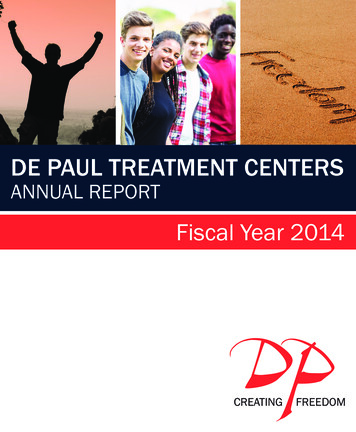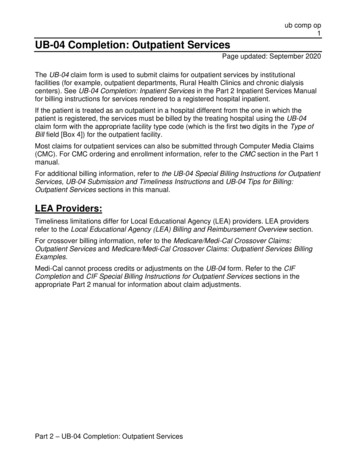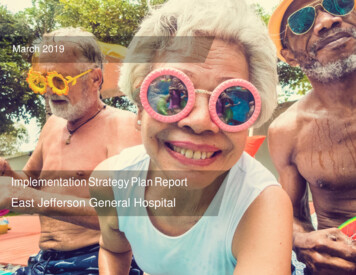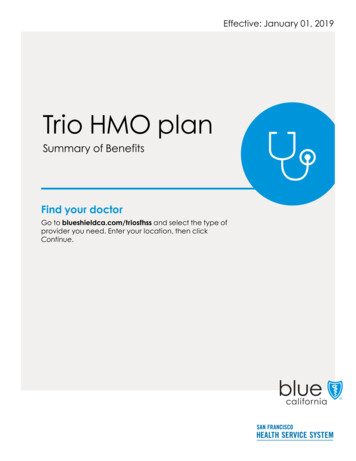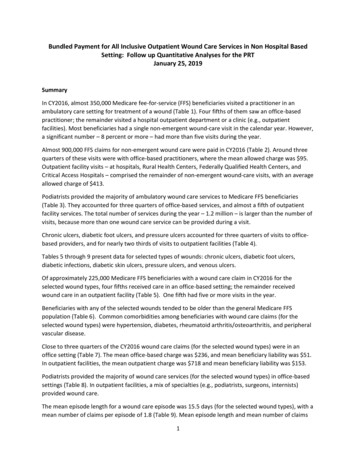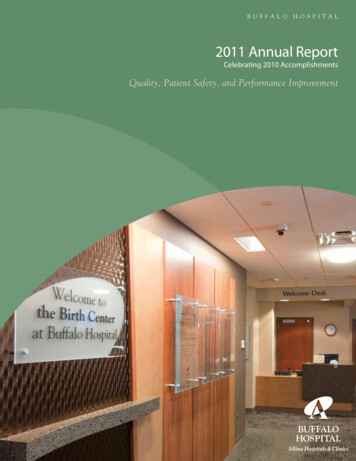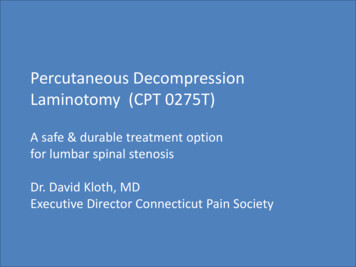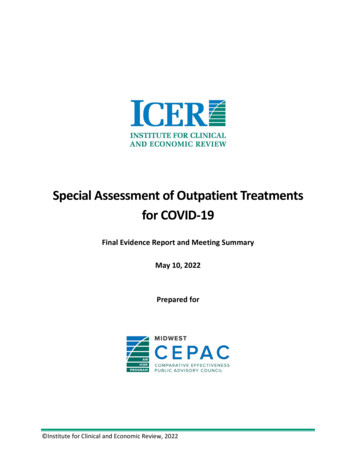
Transcription
Special Assessment of Outpatient Treatmentsfor COVID-19Final Evidence Report and Meeting SummaryMay 10, 2022Prepared for Institute for Clinical and Economic Review, 2022
AUTHORS:Kai Yeung, PharmD, PhDAssistant InvestigatorKaiser Permanente Washington Health Research InstituteMelanie D. Whittington, PhD, MSDirector of Health EconomicsInstitute for Clinical and Economic ReviewMolly Beinfeld, MPHSenior Research Lead, Evidence SynthesisInstitute for Clinical and Economic ReviewRasheed Mohammed, PharmD, MPHHealth Technology Assessment FellowInstitute for Clinical and Economic ReviewAbigail Wright, PhD, MScSenior Research Lead, Evidence SynthesisInstitute for Clinical and Economic ReviewEmily NhanResearch AssistantInstitute for Clinical and Economic ReviewNoemi Fluetsch, MSc, MPHResearch Assistant, Health Economics and Outcomes ResearchInstitute for Clinical and Economic ReviewMarina Richardson, MScHealth EconomistInstitute for Clinical and Economic ReviewSteven D. Pearson, MD, MScPresidentInstitute for Clinical and Economic ReviewDATE OFPUBLICATION:May 10, 2022How to cite this document: Yeung K, Whittington MD, Beinfeld M, Mohammed R, Wright A, Nhan E, Fluetsch N,Richardson M, Pearson SD. Special Assessment of Outpatient Treatments for COVID-19; Final Evidence Report andMeeting Summary. Institute for Clinical and Economic Review, May 10, 2022. https://icer.org/assessment/covid19-2022/.Kai Yeung served as the lead author for the report. Molly Beinfeld led the systematic review and authorship of thecomparative clinical effectiveness section of this report in collaboration with Rasheed Mohammed, Abigail Wright,and Emily Nhan. Melanie Whittington developed the cost-effectiveness model and authored the correspondingsections of the report with assistance from Noemi Fluetsch and Marina Richardson. Steven D. Pearson providedmethodologic guidance on the clinical and economic evaluations. We would also like to thank Laura Cianciolo andMonica Frederick for their contributions to this report. Institute for Clinical and Economic Review, 2022Special Assessment of Outpatient Treatments for COVID-19Page i
About ICERThe Institute for Clinical and Economic Review (ICER) is an independent non-profit research organization thatevaluates medical evidence and convenes public deliberative bodies to help stakeholders interpret and applyevidence to improve patient outcomes and control costs. Through all its work, ICER seeks to help create a future inwhich collaborative efforts to move evidence into action provide the foundation for a more effective, efficient, andjust health care system. More information about ICER is available at https://icer.org/.The funding for this report comes from government grants and non-profit foundations, with the largest singlefunder being the Arnold Ventures. No funding for this work comes from health insurers, pharmacy benefitmanagers, or life science companies. ICER receives approximately 29% of its overall revenue from thesehealth industry organizations to run a separate Policy Summit program, with funding approximately equally splitbetween insurers/PBMs and life science companies. Life science companies relevant to this review whoparticipate in this program include GlaxoSmithKline, Merck, Pfizer, and Regeneron. For a complete list of fundersand for more information on ICER's support, please visit or drug topics, in addition to receiving recommendations from the public, ICER scans publicly availableinformation and also benefits from a collaboration with IPD Analytics, an independent organization that performsanalyses of the emerging drug pipeline for a diverse group of industry stakeholders, including payers,pharmaceutical manufacturers, providers, and wholesalers. IPD provides a tailored report on the drug pipeline ona courtesy basis to ICER but does not prioritize topics for specific ICER assessments.About Midwest CEPACThe Midwest Comparative Effectiveness Public Advisory Council (Midwest CEPAC) – a core program of ICER –provides a public venue in which the evidence on the effectiveness and value of health care services can bediscussed with the input of all stakeholders. Midwest CEPAC seeks to help patients, clinicians, insurers, andpolicymakers interpret and use evidence to improve the quality and value of health care.The Midwest CEPAC is an independent committee of medical evidence experts from across the Midwest, with amix of practicing clinicians, methodologists, and leaders in patient engagement and advocacy. All Councilmembers meet strict conflict of interest guidelines and are convened to discuss the evidence summarized in ICERreports and vote on the comparative clinical effectiveness and value of medical interventions. More informationabout Midwest CEPAC is available at -public-advisory-council-m-cepac/.The findings contained within this report are current as of the date of publication. Readers should be aware that new evidencemay emerge following the publication of this report that could potentially influence the results. ICER may revisit its analyses in aformal update to this report in the future.The economic models used in ICER reports are intended to compare the clinical outcomes, expected costs, and cost effectivenessof different care pathways for broad groups of patients. Model results therefore represent average findings across patients andshould not be presumed to represent the clinical or cost outcomes for any specific patient. In addition, data inputs to ICER modelsoften come from clinical trials; patients in these trials may differ in real-world practice settings. Institute for Clinical and Economic Review, 2022Special Assessment of Outpatient Treatments for COVID-19Page ii
In the development of this report, ICER’s researchers consulted with several clinical experts, patients,manufacturers, and other stakeholders. The following experts provided input that helped guide the ICERteam as we shaped our scope and report. It is possible that expert reviewers may not have had theopportunity to review all portions of this report. None of these individuals is responsible for the finalcontents of this report, nor should it be assumed that they support any part of it. The report should beviewed as attributable solely to the ICER team and its affiliated researchers.For a complete list of stakeholders from whom we requested input, please ICER COVID-19-Stakeholder-List 082621.pdf.Expert ReviewersAndrew D. Badley, MDProfessor of Infectious DiseasesProfessor and Chair, Department of Molecular MedicineChair, SARS-CoV-2 COVID-19 Task ForceMayo ClinicDr. Badley is supported by grants from the National Institute of Allergy and Infectious Diseases, Amfar,and Mayo Clinic. Dr. Badley is a paid consultant for Abbvie, Gilead, Freedom Tunnel, PinetreeTherapeutics, Primmune, Immunome, MarPam, Rion, Symbiosis, and Flambeau Diagnostics, is a paidmember of the Data and Safety Monitoring Board for Corvus Pharmaceuticals, Equilium, CSL Behring,and Excision Biotherapeutics, has received fees for speaking from Reach MD, Peer Voice, and Medscape,owns equity for scientific advisory work in Zentalis Rion, and Nference, and is Founder and President ofSplissen therapeutics.Rajesh Gandhi, MDProfessor of Medicine, Harvard Medical SchoolDirector, HIV Clinical Services and EducationMassachusetts General HospitalCo-Director and Principal Investigator, Harvard University Center for AIDS ResearchDr. Gandhi previously served on a scientific advisory board for a Merck HIV medication.Shivanjali Shankaran, MDAssistant ProfessorDirector, General Inpatient Infectious DiseasesAssociate Director, Adult Antimicrobial Stewardship Program Division of Infectious DiseasesRush University Medical CenterDr. Shankaran served as the principal investigator for “A Phase III Randomized Study to Evaluate theSafety and Antiviral Activity of Remdesivir in Participants With Moderate COVID-19 Compared toStandard of Care Treatment” and “Study to Evaluate the Safety and Antiviral Activity of Remdesivir inParticipants With Severe Coronavirus Disease (COVID-19).” Institute for Clinical and Economic Review, 2022Special Assessment of Outpatient Treatments for COVID-19Page iii
Table of ContentsExecutive Summary . ES1Background . ES1Report Aim . ES1Mechanisms of Action and FDA Regulatory Status . ES2Comparative Clinical Effectiveness . ES2Cost Effectiveness . ES41. Background . 1Report Aim . 22. Patient Caregiver Perspectives . 43. Comparative Clinical Effectiveness . 63.1. Methods Overview . 6Scope of Review . 6Evidence Base. 63.2. Results . 10Clinical Benefits and Harms . 10Subgroup Analyses and Heterogeneity. 13Uncertainty and Controversies . 133.3. Summary and Comment . 18Midwest CEPAC Votes . 214. Long-Term Cost Effectiveness . 224.1. Methods Overview . 224.2. Key Model Assumptions and Inputs . 254.3. Results . 28Base-Case Results . 28Sensitivity Analyses . 28Threshold Analyses. 30Scenario Analyses . 30Model Validation . 33Uncertainty and Controversies . 33 Institute for Clinical and Economic Review, 2022Special Assessment of Outpatient Treatments for COVID-19Page iv
4.4 Summary and Comment . 355. Contextual Considerations and Potential Other Benefits . 36Midwest CEPAC Votes . 386. Health-Benefit Price Benchmarks . 39Midwest CEPAC Votes . 407. Potential Budget Impact . 418. Policy Recommendations . 42Federal Government . 42Guideline Developers . 44Manufacturers. 45Payers and Manufacturers . 45Researchers . 46References . 48Supplemental MaterialsA. Background: Supplemental Information . A1A1. Definitions . A1Intervention Definitions . A1Outcome Measure Definitions . A1A2. Potential Cost-Saving Measures in COVID-19 . A2B. Patient Perspectives: Supplemental Information . B1B1. Methods . B1C. Clinical Guidelines . C1IDSA Guidelines as of April 20, 2022 . C1National Institutes of Health COVID-19 Treatment Guidelines as of April 20, 2022 . C2D. Comparative Clinical Effectiveness: Supplemental Information . D1D1. Detailed Methods . D1PICOTS . D1Data Sources and Searches. D5Study Selection . D8 Institute for Clinical and Economic Review, 2022Special Assessment of Outpatient Treatments for COVID-19Page v
Data Extraction and Quality Assessment . D9Assessment of Level of Certainty in Evidence. D10Assessment of Bias . D10Data Synthesis and Statistical Analyses . D10D2. Additional Clinical Evidence . D10Evidence Base. D10D3. Evidence Tables. D26D4. Ongoing Studies . D129D5. Previous Systematic Reviews and Technology Assessments . D135E. Long-Term Cost-Effectiveness: Supplemental Information . E1E1. Detailed Methods . E1Target Population . E2Treatment Strategies. E3E2. Model Inputs and Assumptions . E4Model Inputs . E5E3. Results . E16Description of evLY Gained Calculations . E16Base-Case Results . E17E4. Sensitivity Analyses . E17E5. Scenario Analyses . E23E6. Model Validation . E24Prior Economic Models . E24F. Public Comments . F1G. Conflict of Interest Disclosures . G1 Institute for Clinical and Economic Review, 2022Special Assessment of Outpatient Treatments for COVID-19Page vi
List of Acronyms and Abbreviations Used in this CWHOAgency for Healthcare Research and QualityBody mass indexCenters for Disease Control and PreventionConfidence intervalEmergency Use AuthorizationEqual-value life yearFood and Drug AdministrationHuman immunodeficiency virusHazard ratioInstitute for Clinical and Economic ReviewIntensive care unitInfectious Diseases Society of AmericaIntravenousKilogramMilligramMilliliterTotal numberNumberNational Institutes of HealthPolymerase chain reactionPopulation, Intervention, Comparators, Outcomes, Timing, SettingsQuality-adjusted life yearRandomized controlled trialRibonucleic acidRisk ratioSevere acute respiratory syndrome coronavirus 2Oxygen saturationSelective serotonin reuptake inhibitorUnited StatesWholesale acquisition costWorld Health Organization Institute for Clinical and Economic Review, 2022Special Assessment of Outpatient Treatments for COVID-19Page vii
Executive SummaryBackgroundCOVID-19 is an infectious respiratory disease caused by the severe acute respiratory syndromecoronavirus 2 (SARS-CoV-2). As of April 2022, there have been over 80 million confirmed COVID-19cases and 980,000 COVID-19 deaths in the United States (US).1 The severity of the disease isclassified into four levels. Most symptomatic COVID-19 patients have mild or moderate disease anddo not require hospitalization. Patients who develop severe or critical disease requirehospitalization with respiratory support. Many factors can increase the risk for developing severeor critical COVID-19. Some of the most common risk factors are older age, obesity, cardiovasculardisease, and chronic obstructive pulmonary disease.This Evidence Report is considered an Institute for Clinical and Economic Review (ICER) SpecialAssessment because the epidemiological landscape and evidence base for potential treatments forCOVID-19 are both rapidly evolving and will continue to change throughout and beyond the courseof this review. This constantly shifting landscape is a dominant contextual reality. However, due tothe unprecedented immediacy and scale of COVID-19, and the near-term policy decisions that willbe made across multiple treatment options, ICER believes that an independent review of existingevidence on comparative clinical effectiveness and value of these treatment options will be helpfulto all stakeholders.Report AimIn this Evidence Report, ICER is presenting a full evaluation of clinical and economic outcomes ofthree treatments for mild-to-moderate COVID-19 among outpatients at high risk of progression tosevere disease: molnupiravir, Paxlovid , and fluvoxamine. The scope of the review had additionallyincluded two monoclonal antibody treatments, REGEN-COV and sotrovimab. However, neithertreatment currently has emergency use authorization (EUA) from the Food and Drug Administration(FDA) for use in any US region due to substantially reduced activity against the Omicron variant andOmicron BA.2 subvariant, respectively.2,3 Around the time of posting of the draft Evidence Report,the FDA granted EUAs for remdesivir and bebtelovimab for our population of interest. Further,peginterferon lambda is seeking EUA based upon recent positive trial results.4 While thesetreatments emerged too late for us to consider in the Evidence Report, we note that the interactiveeconomic model will be available on ICER Analytics. Decisionmakers can input clinical andeconomic data on other emerging treatments to generate cost-effectiveness results and suggestedhealth-benefit price benchmarks. Institute for Clinical and Economic Review, 2022Special Assessment of Outpatient Treatments for COVID-19Page ES1Return to Table of Contents
Mechanisms of Action and FDA Regulatory StatusMolnupiravir is an oral ribonucleoside analog that causes viral genome replication errors.Nirmatrelvir/ritonavir (Paxlovid) is a combination oral drug that inhibits SARS-CoV-2-3CL protease,an enzyme necessary to produce other functional SARS-CoV-2 proteins. Fluvoxamine is an oralselective serotonin reuptake inhibitor (SSRI) with FDA approval for the treatment of obsessivecompulsive disorder. One hypothesized mechanism of action for fluvoxamine in the treatment ofCOVID-19 is through modulation of the body’s inflammatory response. Molnupiravir and Paxlovidcurrently have EUAs from the FDA. Fluvoxamine is available on the US market while universitybased researchers are pursuing an EUA specifically for the treatment of COVID-19.Comparative Clinical EffectivenessStudies of all three therapies were conducted in overlapping timeframes but with potentiallyimportant differences in location (US vs. overseas), and in the spectrum and relative prevalence ofSARS-CoV-2 variants within the population. None of the clinical trials were performed at a timewhen the Omicron variant was present. Within this context, trial results demonstrated that, if givenwithin a limited number of days following initial symptoms of COVID-19, all three drugs of interestwere superior to placebo in reducing hospitalization related to the acute infection. Molnupiravirand Paxlovid significantly reduced the relative risk of hospitalization or death from any causecompared to placebo by 30% and 88%, respectively. Fluvoxamine reduced the relative risk ofCOVID-19-associated acute care (i.e., retention in a COVID-19 emergency setting or transfer totertiary hospital due to COVID-19) by 32% over placebo. A per-protocol analysis of fluvoxaminelimited to individuals who did not stop treatment (i.e., had greater than 80% adherence) suggestedsubstantially greater efficacy (66% relative risk reduction) in reducing acute care use.Molnupiravir and Paxlovid were well tolerated and had low discontinuation rates in their Phase IIIclinical trials. However, each drug has some notable risks. With molnupiravir there were importantsafety considerations given laboratory evidence suggesting it may be mutagenic, teratogenic, andtoxic to growing bone and cartilage. Based on a short five-day course of therapy, the FDA considersmolnupiravir to have low risk for mutagenicity, but the EUA label limits usage to individuals 18 yearsand older who are not pregnant or breastfeeding and who are without alternative COVID-19treatment options.5 The FDA also recommends that men of reproductive potential who are sexuallyactive with individuals of childbearing potential should abstain from sex or use a reliable method ofcontraception for the duration of treatment and for at least three months after the last dose ofmolnupiravir. Molnupiravir is only authorized for individuals for whom alternative COVID-19treatment options approved or authorized by the FDA are not accessible or clinically appropriate.Paxlovid is a combination therapy containing ritonavir. Ritonavir has many known drug-druginteractions that pose a safety risk. These include interactions with certain anticoagulants, Institute for Clinical and Economic Review, 2022Special Assessment of Outpatient Treatments for COVID-19Page ES2Return to Table of Contents
antiplatelets, antiarrhythmics, anticonvulsants, and immunosuppressants.6 These interactions maybe more common among certain patients who are at particularly high risk for severe COVID-19disease (e.g., immunosuppressed patients).7 Paxlovid is not recommend for patients with severerenal or hepatic impairment.As an SSRI, fluvoxamine also carries an FDA drug class warning for increased risk of suicidal thinkingfor children, adolescents, and young adults taking antidepressants for major depressive disorderand other psychiatric disorders. The risk of adverse events in the fluvoxamine arm was similar tothe risk in the placebo arm of the Phase III TOGETHER trial as well as to the risks in interventionarms in the Phase III trials for the other drugs of interest. However, there was a sizeable percentageof individuals who stopped treatment due to tolerability in both the fluvoxamine and placebo armsof the TOGETHER trial (11.3% and 8.4%, respectively).Table ES1. Number and Percentage of Hospitalizations or Deaths in Key Phase III Trials6,8-13Intervention (Trial)Hospitalization or Death from AnyCause, n/N (%)InterventionPlacebo48/709 (6.8)68/699 (9.7)8/1,039 (0.8)66/1,046 (6.3)79/741 (11)*119/756 (16)*Death, n/N (%)InterventionMolnupiravir (MOVe-OUT)1/709 (0.1)Paxlovid (EPIC-HR)0/1,039 (0)Fluvoxamine (TOGETHER)17/741 (2.3)n: number, N: total number*Observed in a COVID-19 emergency setting (for more than six hours) or hospitalized.Placebo9/699 (1.3)12/1,046 (1.1)25/756 (3.3)While further evidence on all three treatments of interest continues to be gathered and analyzed,the COVID-19 landscape has been evolving so rapidly that currently available data cannot beexpected to have evaluated the safety and effectiveness of these drugs in the real-world USpopulation as of the date of this report. Important uncertainties that must be considered include:1) the rapid evolution of SARS-CoV-2 leading to variants with treatment resistance and withdifferent morbidity and mortality impacts; 2) the enrollment of predominantly unvaccinatedpatients who were generally healthier and lower risk than those in the general population; and 3)the uncertain generalizability of data related to hospitalization rates and other health care resourceutilization from studies conducted prior to the advent of the Omicron variant and basedpredominately or exclusively in countries outside of the US. Such issues are compounded by theearly phase of evidence generation in which only one Phase III trial has been conducted for eachdrug in the population of interest at this time.Substantial differences in patient populations across the Phase III trials preclude us from makingdirect comparisons or formal quantitative indirect comparisons of safety and effectiveness acrossthe drugs of interest. For example, the molnupiravir trial enrolled substantially larger proportionsof individuals with obesity compared to the fluvoxamine and Paxlovid trials. Further, as noted,large variability in the countries of recruitment and the timing of trial enrollment periods reducestudy comparability. The Phase
Mayo Clinic. Dr. Badley is supported by grants from the National Institute of Allergy and Infectious Diseases, Amfar, . Symbiosis, and Flambeau Diagnostics, is a paid member of the Data and Safety Monitoring Board for Corvus Pharmaceuticals, Equilium, CSL Behring, and Excision Biotherapeutics, has received fees for speaking f rom Reach MD .
